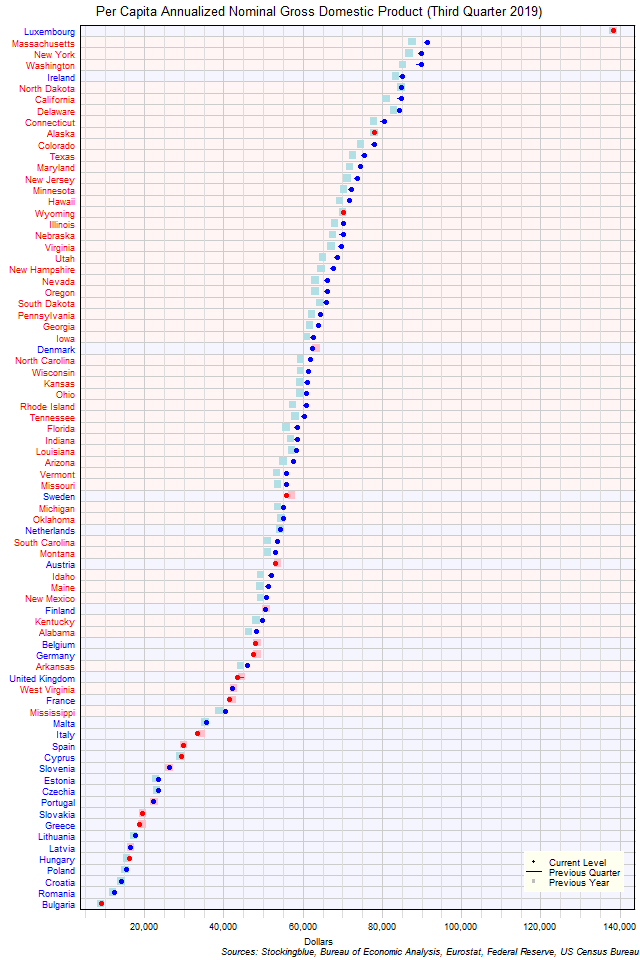
The chart above shows the per capita annualized nominal gross domestic product (GDP) in each EU and US state as of the third quarter of 2019 in dollars, the change from the previous quarter, and the GDP one year prior. Luxembourg is in a class all by itself.
Findings
- The difference between the state with the largest per capita GDP, Luxembourg, and the state with the smallest, Bulgaria, is $129,332.60 (up from $129,242.93 last quarter and up from $129,304.92 last year). Luxembourg and Bulgaria had the largest and smallest per capita GDP respectively both last quarter and last year.
- Luxembourg has 15.19 times the per capita GDP that Bulgaria does. The ratio of largest per capita GDP to smallest per capita GDP was up from 14.86 last quarter and down from 15.37 last year.
- The median per capita GDP in the 28 EU states is $29,502.18 (down from $29,599.28 last quarter and down from $29,514.84 last year) and the mean $37,232.10 (down from $37,288.08 the previous quarter and down from $37,364.66 last year).
- The median per capita GDP in the 50 US states is $63,230.45 (up from $62,593.80 last quarter and up from $61,306.31 last year) and the mean $64,851.61 (up from $64,278.35 the previous quarter and up from $62,696.35 last year).
- The median per capita GDP in the 78 EU and US states is $56,775.09 (up from $56,577.03 last quarter and up from $55,394.66 last year) and the mean $54,936.91 (up from $54,589.54 the previous quarter and up from $54,589.54 last year).
- Sixty-two states (14 EU, 48 US) saw their per capita GDP rise in current dollars from the previous quarter while 16 saw their per capita GDP drop (14 EU, 2 US).
- Sixty-two states (13 EU, 49 US) saw their per capita GDP rise in current dollars from last year while 16 saw it drop (15 EU, 1 US).
- All EU drops in per capita GDP except for the United Kingdom's, Greece's, and Bulgaria's quarterly drop are attributed to currency rate fluctuations.
Caveats
- GDP data is from the third quarter of 2019, the second quarter of 2019, and the third quarter of 2018.
- US census data is from 2010, EU census data is from 2011.
- The data is seasonally adjusted in current dollars.
- Euros are converted to dollars at an average exchange rate of 1.11 for the third quarter of 2019, 1.12 for the second quarter of 2019, and 1.16 for the third quarter of 2018 according to historic rates listed at the Federal Reserve (see source link below).
- US data comes in an annualized format which the EU does not, thus EU data is annualized by multiplying the quarterly figure by four.
- US growth rates may differ from those provided by the Bureau of Economic Analysis as the BEA's growth rates are based on chained dollars in conjunction with the chain index or the quality index for real GDP. The growth rates listed here are based on nominal GDP.
- All figures are rounded to the nearest hundredth.
Details
In absolute terms, the United Kingdom saw the largest decrease over the previous quarter with a drop of $1,429.22. Washington had the largest growth with a gain of $1,094.54. Year over year, Sweden had the largest decrease with a drop of $1,476.62 while Washington had the greatest increase with a gain of $4,542.54.
In relative terms, the United Kingdom had the largest decrease over the previous quarter with a 3.18% drop in per capita GDP while Romania had the greatest increase with a 1.83% rise in per capita GDP. Year over year, Greece had the largest contraction with a 3.14% drop in per capita GDP while Rhode Island had the largest growth with a 5.78% rise in per capita GDP.
The number of states with a per capita GDP of over $75,000 was ten last year, 11 the previous quarter, and 12 this past quarter. Conversely, the number of states with a per capita GDP of less than $50,000 was 29 last year, 26 the previous quarter, and 26 this past quarter.
Florida (from 38th largest per capita GDP to 36th largest) and Alabama (56th to 54th) each surpassed two states over the previous quarter. Louisiana (from 36th to 38th), Sweden (from 40th to 42nd), and Austria (from 46th to 48th) were each surpassed by two states. Year over year, Vermont (from 46th to 40th) bested six states. On the flip side, Denmark (24th to 29th) and Sweden (37th to 42nd) were each bested by five states.
Ireland was the only EU state to overcome a US state both over the previous quarter and over the same quarter last year. Meanwhile, six US states surpassed five EU states over the previous quarter and 19 US states surpassed eight EU states over the same quarter last year. This disparity is partially due to the rise of the dollar against the euro over the course of the past quarter and past year.
Sources
Eurostat. 2020. "GDP and Main Components." Accessed January 29, 2020. https://appsso.eurostat.ec.europa.eu/nui/show.do?query=BOOKMARK_DS-406779_QID_-583B1285_UID_-3F171EB0&layout=TIME,C,X,0;GEO,L,Y,0;UNIT,L,Z,0;S_ADJ,L,Z,1;NA_ITEM,L,Z,2;INDICATORS,C,Z,3;&zSelection=DS-406779UNIT,CP_MEUR;DS-406779INDICATORS,OBS_FLAG;DS-406779S_ADJ,SCA;DS-406779NA_ITEM,B1GQ;&rankName1=UNIT_1_2_-1_2&rankName2=INDICATORS_1_2_-1_2&rankName3=NA-ITEM_1_2_-1_2&rankName4=S-ADJ_1_2_-1_2&rankName5=TIME_1_0_0_0&rankName6=GEO_1_2_0_1&sortC=ASC_-1_FIRST&rStp=&cStp=&rDCh=&cDCh=&rDM=true&cDM=true&footnes=false&empty=false&wai=false&time_mode=NONE&time_most_recent=false&lang=EN&cfo=%23%23%23%2C%23%23%23.%23%23%23.
Eurostat. 2017. "Population on 1 January by Age Groups and Sex - Functional Urban Areas." Accessed December 11, 2017. http://appsso.eurostat.ec.europa.eu/nui/show.do?dataset=urb_lpop1&lang=en.
Federal Reserve. 2020. "Foreign Exchange Rates." Accessed January 30, 2020. https://www.federalreserve.gov/releases/g5/.
US Bureau of Economic Analysis. 2020. "GDP by State." Accessed January 28, 2020. https://www.bea.gov/data/gdp/gdp-state.
United States Census Bureau. September 2012. "United States Summary: 2010: Population and Housing Unit Counts." Accessed January 23, 2018. https://www.census.gov/prod/cen2010/cph-2-1.pdf.